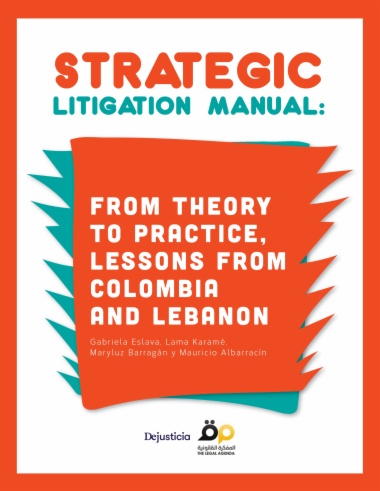Strategic Litigation Manual: From Theory to Practice, Lessons from Colombia and Lebanon” aims to address every step of the process of strategic litigation. The first part discusses how to select a strategic case and its components; followed by part two, which provides practical insights on the litigation itself; and the part three explores the post-decision phase. In that sense, the manual contains ten key steps that should be developed in a human rights litigation strategy. These steps include identifying the injustice to be remedied, envisioning the goal, developing a legal strategy, selecting the parties, assessing risks and resources, collecting evidence, developing legal arguments, building an outreach strategy, ensuring that a win is effective or investing in a loss and, learning and retooling. The manual presents a theoretical conception of each of these steps, followed by an illustration of real case examples gathered from the litigation experience of Dejusticia and The Legal Agenda, allowing the reader to understand strategic litigation in theory and practice. This model is not meant to be prescriptive and it is based in our practice on litigation. It is intended to be used as a toolkit to be improved upon with lessons learned from every case. As learning is a key pillar of this model, we encourage readers to retool the model and keep improving it with each new case they pursue.
- Cover
- Title page
- Copyright page
- Table of contents
- Foreword
- Introduction
- Part 1: Selecting the Case
- Step 1: Identifying the injustice to be remedied
- Case Study 1: Forced Disappearances After the Lebanese Civil War
- Case Study 2: The Land Rights of Afro-Colombian Communities
- Step 2: Envisioning the Goal
- Case Study 3: Litigation on Behalf of Refugees in Lebanon
- Case Study 4: Social Stigma Against People Living with HIV in Colombia
- Step 3: Developing a Legal Strategy
- Case Study 5: Litigating the “Right to Know” in Lebanon
- Case Study 6: Recognizing the “Right to Defend Human Rights” in Colombia
- Step 4: Selecting the Parties
- Case Study 7: “To Take into Account the Campesino” in Colombia
- Step 5. Assessing Risks and Resources
- Case Study 8: Universal Right to Health Regardless of Migration Status in Colombia
- Part 2: Litigating the Case
- Step 6: Collecting Evidence
- Case Study 9: Understanding Technical Evidence in Lebanon
- Case Study 10: Death from Malnutrition in Colombia
- Step 7: Developing Legal Argument
- Case Study 11: LGBTQ+ Rights in Lebanon
- Case Study 12: Freedom of Expression and Access to Information in Colombia
- Step 8: Building an Outreach Strategy
- Case Study 13: Media Pressure for Iraqi Refugees in Lebanon
- Case Study 14: The Amazon and the Rights of Future Generations, Part 1
- Part 3: Working with the Decision
- Step 9: Ensuring that a Win is Effective or Investing in a Loss
- Case Study 15: Forced Displacement in Colombia
- Case Study 16: The Hashisho Law in Lebanon
- Step 10: Learning and Retooling
- Case Study 17: The Amazon and the Rights of Future Generations, Part 2
- References
- About the authors
- Acknowledgments

